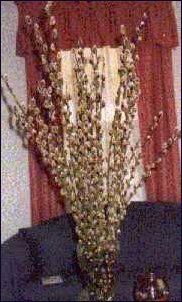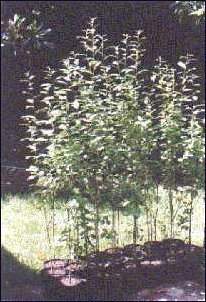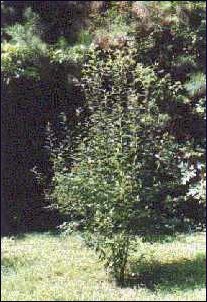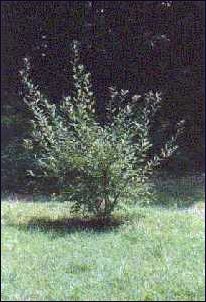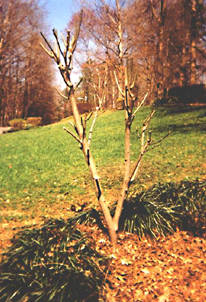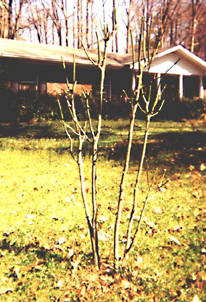
The willow genus, Salix, is one of the largest in the plant kingdom.
There are scores of species scattered throughout the temperate and frigid
zones of North America, Asia and Europe. All species of willows are
dioecious, i. e. the male and female parts called catkins (kotiki) appear
on separate plants. The male catkins are generally showier and the flowering
branches of the males of a few of the showier species are chosed for
use in the processions of Willow Sunday to herald the Resurrection.
In Europe it is the species, Salix caprea, and in North America, Salix
discolor, which are selected for that function. The flowers or catkins
appear in late winter when most other flora has not yet risen from the
dormancy of winter. The above mentioned species of pussy willow are easily propagated by
taking cuttings 1 foot long in late winter at the time when they begin
to bloom (generally March), placing them in containers in 2 inches of
water, and setting the containers in a bright window. Care must be taken
that the tips of the buds in the branch point upward. In a few weeks
the branches will begin to grow roots. When the roots are 3 - 4 inches
long, the rooted branches should be planted in good soil in gallon size
plastic containers (available from the recycling bins of many garden
centers) and placed in a bright window until danger of frost has passed.
At that time the branches will begin to show green growth. After danger
of frost has passed, the plants should be moved outside, placed in the
sun, and kept well watered throughout the summer. Occasionally a light
application of liquid fertilizer may be made to promote growth. (An
alternative to the above which is usually less successful is to plant
the rooted branches after the last frost directly in the permanent location).
In October the potted plants should be set out in their permanent location
at least 10 feet apart from each other. In selecting a permanent location,
care must be taken to select a site which is sunny and damp, optimally
near streams or drainage areas, but not near septic tanks because the
roots of willows will invade the drain field. During the first winter
in the ground the willow's roots will move into the adjacent soil. During
the first summer in the ground the plants should be watered frequently
to assist in the roots' penetration into the soil. In March and May
light applications of 5-10-5 or 5-10-10 fertilizer should be applied
around the plants, but not near the stems, to encourage growth and the
formation of catkin buds. In areas with rabbits, the stems or trunks
of the plants viz. small trees should be surrounded by 1-inch mesh chicken
wire 36 inches tall availably in hardwares to discourage rabbits' foraging
on the lower branches. Once in the ground pussy willows grow quickly,
particularly if well watered and fertilized occasionally. Toward the
end of the first or second winter in the ground one will notice the
formation of large buds on the branches of the current summer's growth.
These buds contain the catkins. When the catkins have broken half way
out of their buds at the end of the following winter, it is time to
begin harvesting. Because the Easter cycle varies so much, one cannot
be sure that the catkins in their prime will match the ecclesiatical
calendar. Usually the catkins are in their prime before, sometimes weeks
before Willow Sunday, particularly in the South. Gathering the flowering
branches in their prime and holding them in good condition require that
they be cut into 12 to 15 inch segments and stored in a cool place until
the day before Willow Sunday. To maintain pussy willows in prime production
of catkin bearing branches, they must also be pruned radically (no higher
than 5 feet) at the time of each harvest to keep them low and easily
accessible and to promote new young growth upon which the catkins appear.
In Europe the bushes are cut down every few years and heavily fertilized
to promote the growth of numerous new branches which are cut for the
florist trade. Many churches and monasteries which possess suitable land and parishioners
willing to undertake the project, might consider the cultivation of
pussy willows, not only for their own use, but also for distribution
or sale to other churches which have neither land nor inclination to
grow their own, as a source of additional funds for church use. In this
manner they not only serve to keep a valuable tradition from expiring
from non-use, but also generate funds to supplement church income. Willow
branches may be placed in a plastic bag in a cardboard tube available
from office supply stores and sent everywhere by UPS or priority mail. INTERESTED PARISHIONERS OF ORTHODOX AND GREEK-CATHOLIC CHURCHES
OF THE BYZANTINE-SLAVONIC LITURGICAL TRADITION IN THE UNITED STATES
AND CANADA ARE INVITED TO REQUEST CUTTINGS OF BRANCHES FOR PROPAGATION
PURPOSES. ALL SUCH REQUESTS MUST BE SUBMITTED BEFORE FEBRUARY 28 BY
E-MAIL TO: rlschwind@aol.com.
PLEASE INCLUDE YOU NAME AND POSTAL ADDRESS. OTHERS MAY PURCHASE PLANTS
OF THE EUROPEAN AND JAPANESE SPECIES OF PUSSY WILLOW AT FORESTFARM
NURSERY (www.forestfarm.com)
IN WILLIAMS, OR. FORESTFARM ALSO SELLS A BEAUTIFUL VARIANT OF THE JAPANESE
PUSSY WILLOW, SALIX CHAENOMELOIDES, CALLED "MT. ASO" WHICH
BEARS LARGE RED CATKINS. Resurrection Troparion in Old Slavonic Christos
voskrese iz mertvikh,
Pussy
Willows in cultivation Salix
caprea Salix discolor Salix chaenomeloides Garden of Our Lady of the Willow Willows after Pruning
Return
to Index. |
||||||||||

